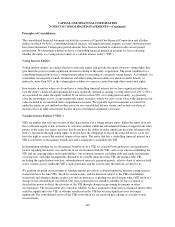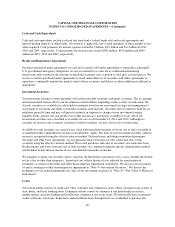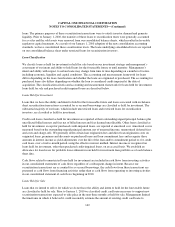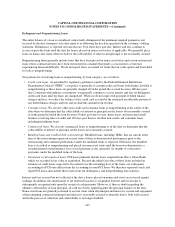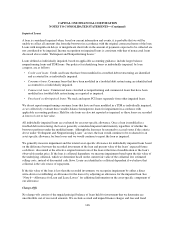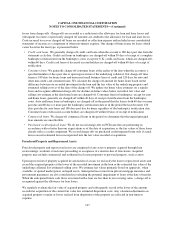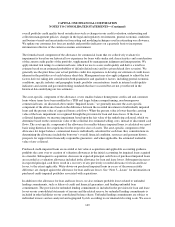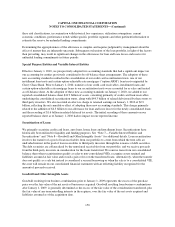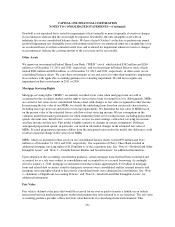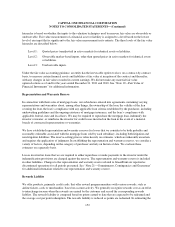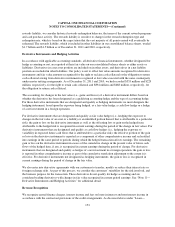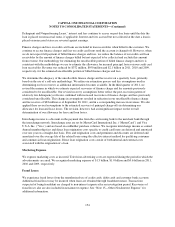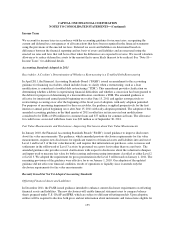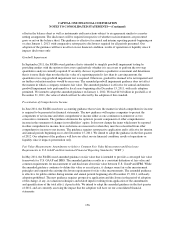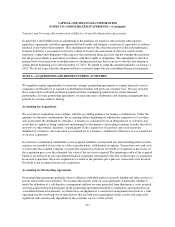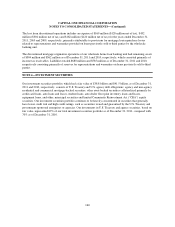Capital One 2011 Annual Report Download - page 170
Download and view the complete annual report
Please find page 170 of the 2011 Capital One annual report below. You can navigate through the pages in the report by either clicking on the pages listed below, or by using the keyword search tool below to find specific information within the annual report.CAPITAL ONE FINANCIAL CORPORATION
NOTES TO CONSOLIDATED STATEMENTS—(Continued)
these risk classifications, in conjunction with historical loss experience, utilization assumptions, current
economic conditions, performance trends within specific portfolio segments and other pertinent information to
estimate the reserve for unfunded lending commitments.
Determining the appropriateness of the allowance is complex and requires judgment by management about the
effect of matters that are inherently uncertain. Subsequent evaluations of the loan portfolio, in light of the factors
then prevailing, may result in significant changes in the allowances for loan and lease losses and reserve for
unfunded lending commitments in future periods.
Special Purpose Entities and Variable Interest Entities
Effective January 1, 2010, we prospectively adopted two accounting standards that had a significant impact on
our accounting for entities previously considered to be off-balance sheet arrangements. The adoption of these
new accounting standards resulted in the consolidation of our credit card securitization trusts, one of our
installment loan trusts and certain option-adjustable rate mortgages (“option-ARM”) loan trusts originated by
Chevy Chase Bank. Prior to January 1, 2010, transfers of our credit card receivables, installment loans and
certain option-adjustable rate mortgage loans to our securitization trusts were accounted for as sales and treated
as off-balance sheet. At the adoption of these new accounting standards on January 1, 2010, we added to our
reported consolidated balance sheet $41.9 billion of assets, consisting primarily of credit card loan receivables
underlying the consolidated securitization trusts, along with $44.3 billion of related debt issued by these trusts to
third-party investors. We also recorded an after-tax charge to retained earnings on January 1, 2010 of $2.9
billion, reflecting the net cumulative effect of adopting these new accounting standards. This charge primarily
related to the addition of $4.3 billion to our allowance for loan and lease losses for the newly consolidated loans
and the recording of $1.6 billion in related deferred tax assets. The initial recording of these amounts on our
reported balance sheet as of January 1, 2010 had no impact on our reported income.
Securitization of Loans
We primarily securitize credit card loans, auto loans, home loans and installment loans. Securitizations have
historically been utilized for liquidity and funding purposes. See “Note 7—Variable Interest Entities and
Securitizations” and “Note 8—Goodwill and Other Intangible Assets” for additional details. Loan securitization
involves the transfer of a pool of loan receivables from our portfolio to a trust from which the trust sells an
undivided interest in the pool of loan receivables to third-party investors through the issuance of debt securities.
The debt securities are collateralized by the transferred receivables from our portfolio, and we receive proceeds
from the third-party investors in consideration for the loans transferred. We remove loans from our consolidated
balance sheet when securitizations qualify as sales to non-consolidated VIEs, recognize assets retained and
liabilities assumed at fair value and record a gain or loss on the transferred loans. Alternatively, when the transfer
does not qualify as a sale but instead is considered a secured borrowing or when the sale is to a consolidated VIE,
the asset will remain on our consolidated financial statements with an offsetting liability recognized for the
amount of proceeds received.
Goodwill and Other Intangible Assets
Goodwill resulting from business combinations prior to January 1, 2009 represents the excess of the purchase
price over the fair value of the net assets of businesses acquired. Goodwill resulting from business combinations
after January 1, 2009, is generally determined as the excess of the fair value of the consideration transferred, plus
the fair value of any noncontrolling interests in the acquiree, over the fair value of the net assets acquired and
liabilities assumed as of the acquisition date.
150


